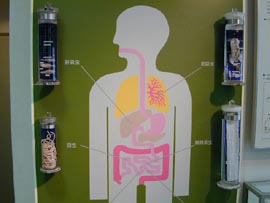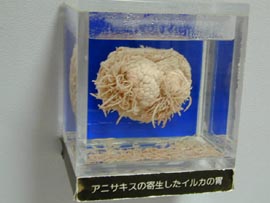Museum Tour: The Meguro Museum of Parasitology
One in an Occasional Visit to a Japanese Museum
On a recent Sunday afternoon I stood
at my office window and peered out at the year's first snow
lightly dusting the city. Over my shoulder, my radio was updating
the traffic situation on the roads and at the airports for
the New Year's holiday returnees. Sometimes cold holidays
help in the appreciation of the average day, I thought, just
after recapping my bottle and stuffing my Santa
suit back into its box. I worked my way back to my desk and
reached around for my lighter in the top drawer. I lit up
an afternoon smoke and stepped into the newsroom with my empty
coffee cup.
 Junior
reporter Junko
had not yet arrived at her desk. Two bags of the latest Starbucks
brew - Papua New Guinea Peaberry - sat propped on her chair.
Christ, what's next, East Timor Eggnog? Must be from an admirer
that has a difficult time showing his affection by stealing
panties like everyone else.
Junior
reporter Junko
had not yet arrived at her desk. Two bags of the latest Starbucks
brew - Papua New Guinea Peaberry - sat propped on her chair.
Christ, what's next, East Timor Eggnog? Must be from an admirer
that has a difficult time showing his affection by stealing
panties like everyone else.
Just as I was about to pour out a slug of standard newsroom issue inspiration, the doors opened and Junko entered.
"Glad you could join us today," I chided, even though I knew she would have a perfectly legitimate reason for her late arrival. She always does. In her eyes, I never do, but she also has a lot to learn.
"I was down to the parasite museum in Meguro," she said. "I read in the newspaper that a new parasite has been sweeping Japan recently and I wanted to do some research."
I set my coffee cup on a file cabinet and stood while my cigarette burned in my right hand.
The Washington Post likens the behavioral traits of this new species to typical parasites on display at the Meguro Museum of Parasitology (10-minute walk from Meguro Station). It reports that this new parasite is indigenous to Japan, but some small mutations have been shown cropping up in the States and Europe.
Identifying characteristics include: unmarried human (typically female, but not always), aged between 20 and 35 years, lives with parents, possesses a reasonable job and a large disposable income. The species name is "parasite single."
Generally, the samples at the museum are of
parasites from all across Japan with further information on
other parasites from around the world. But amongst the hundreds
of animal parasites at the museum transmitted from fish or
cattle or through sandbox or pool, it has yet to allot space
for the parasite single.
This lack of respect toward the parasite single
in the scientific community is bound to change as the descriptive
term has entrenched itself in the Japanese lexicon like a
shistosoma japonicum might in an unsuspecting liver.
But how much does an animal parasite really differ from its
parasite single brethren? A tour of the museum reveals that
although inhabiting very different environments both variations
encounter surprisingly similar difficulties as they move through
life, or small intestine. Additionally, while the prospect
of hosting a parasite single is amazingly easy (though some
advance planning is required considering the age restrictions),
the museum shows that the process for acquiring an animal
parasite to also be but a few easy steps away.
In first looking at both parasite variations, habitation is an obvious concern. Where do these parasites live? The museum has complete walls with shelves of display jars of the small worms that crawl, swim, and slither inside the intestines, livers, and stomachs of their Japanese hosts. From the diphyllobothrium nihonkaiense to the ascaris lumbricoides, the homes of choice for these critters are decided by their ability to find a safe haven during the course of their cyclical life spans. The parasite single too seeks a haven - its parents' apartment or home. Thus creating a haven from rent, a haven from laundry and housework chores, and a haven from meal charges.
 There
of course must be drawbacks to the parasitic lifestyle. How
does the parasite adapt? For the parasite single, there are
indeed hurdles. Tight Japanese traffic puts a crimp in sports
car pleasure and all the time changes from the overseas trips
take their toll on the system. At least that must be the case
given this description by The Post of a certain female
in the species: "She is 26 years old, beautiful, drives
a BMW and carries a $2,800 Chanel handbag - when she isn't
using her Gucci, Prada or Vuitton purses. She vacations in
Switzerland, Thailand, Los Angeles, New York and Hawaii."
The animal parasite suffers similar troubles. For a diphyllobothrium
nihonkaiense that means adapting its exterior during movements
from the innards of crustacean to fish to human. Probably
just as strenuous as flying economy class or downshifting
in traffic.
There
of course must be drawbacks to the parasitic lifestyle. How
does the parasite adapt? For the parasite single, there are
indeed hurdles. Tight Japanese traffic puts a crimp in sports
car pleasure and all the time changes from the overseas trips
take their toll on the system. At least that must be the case
given this description by The Post of a certain female
in the species: "She is 26 years old, beautiful, drives
a BMW and carries a $2,800 Chanel handbag - when she isn't
using her Gucci, Prada or Vuitton purses. She vacations in
Switzerland, Thailand, Los Angeles, New York and Hawaii."
The animal parasite suffers similar troubles. For a diphyllobothrium
nihonkaiense that means adapting its exterior during movements
from the innards of crustacean to fish to human. Probably
just as strenuous as flying economy class or downshifting
in traffic.
All this moving around must make for some rather tolerant hosts. Why do they put up with their parasites? The museum reveals that human hosts for
animal parasites just flat out don't have a choice. Through lack of hygiene, the eating of uncooked or improperly prepared food, or residing in inappropriate environments the host dooms himself to his own fate. Likewise, grand treatment for the
parasite single, The Post insinuates, is due to the belief that one day it will return to the nest and assist the host when it becomes elderly. Further, some parasite singles have led The Post to conclude that a large segment of society believes that they deserve this treatment because "they are trailblazers, trying to find a path different from their mothers'."
But should the parasite single's host
eventually tire of its lovable leech and wish to make a trade for an
animal standby, the museum offers a series of guides that show the acquisition process to be a lot easier than blazing a trail with a BMW during a Tokyo rush hour.
The only difficulty perhaps might be in deciding on
which sucker is suitable.
In search of a little colon companionship? An
anisakis simplex might just be the answer. Just
intake a few servings of uncooked fish or squid that have been feeding on shrimp which themselves have been in the vicinity of dolphin waste and this little white stringy bugger might accompany each of your morning movements.
Liver feeling lonely? All it may
require is the ingestion of a few unwashed berries that have been in contact with fox waste and
an echinococcus multilocularis could be soon swimming with your whiskey and water.
 So it seems that as long as there are adequate hosts, sustainability of the
animal parasite would appear endless. But for the parasite single, does it end? Masahiro Yamada, a sociology professor at Tokyo Gakugei University, who coined the term for the species, told The Post that most singles feel that "whatever they do is not going to make any difference. So they might as well relax and enjoy themselves."
So it seems that as long as there are adequate hosts, sustainability of the
animal parasite would appear endless. But for the parasite single, does it end? Masahiro Yamada, a sociology professor at Tokyo Gakugei University, who coined the term for the species, told The Post that most singles feel that "whatever they do is not going to make any difference. So they might as well relax and enjoy themselves."
Just be sure to wash those berries.
I ran the fingers of my right hand along the edge of the cabinet and fished a fresh smoke from my pack. She was now seated at her desk.
"But from your description," I said, "you are a parasite single yourself. You live with your parents," I began to count on my left hand. "You dispose of income quicker than I do dirty underwear. And your plans for marriage are approaching as swiftly as reforms to construction contract bid rigging laws."
"Yep, great isn't it?" she said. She pushed the bags of coffee to the side of her desk and started on some paperwork.
"So, since there is a nice name for your lifestyle, is there one for a hard-working-nose-to-the-grindstone-shoulder-to-the-wheel man such as myself?" I lit my cigarette.
 "Sure, you're an oyaji."
"Sure, you're an oyaji."
"What's that?" I blew two puffs.
"In summary, you are a middle-aged man. Your main hobbies are chasing girls," at that point my chest filled with pride, "and drinking and smoking heavily. You are developing a paunch and your newspaper of choice is the sports page."
"Well," I started to say with my chest slowly receding inward from its prior position of distention, "as you know, I am a belts and suspenders guy. You know, the old ways are the only ways." I pulled at my sides with my thumbs but only managed to stick my ribs. I've got to remember that I only use that line for figurative character description purposes.
"I'll administer a test next week," she added. "That way we can verify for sure if you are indeed a member of the species. Preliminarily though, I have no doubts."
"So who gave you the coffee?" I asked. I don't think that label she gave me was complimentary, contrary to her initial description. Changing the subject, I figured, was wise until I had all the facts. Plus my little pick-me-up was still on order.
"Oh I don't know. Probably some single guy with a large disposable income that lives with his parents. We are everywhere."
I held out my empty cup. "Well, as you can see, I'm pretty low here. Why not brew us up some of that highbrow mud?"
She didn't give any response. She didn't even look up. She probably knew that in silence we would only be able to hear the newsroom coffee machine perking away in the corner. That would then be her answer.

